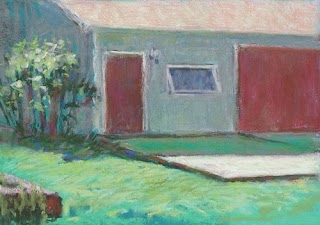This week, I'm in Georgia visiting family. While helping out my elderly parents, I'm finding time to paint. Yesterday, I did this 5x7 pastel sketch of my father's workshop. I was attracted primarily to the strong sunlight on the pavement and the contrast with the shadowed building.
But that old bugaboo, perspective, gave me trouble. From where I sat, the effect was very slight, and I found it difficult to render it properly, given the tight tolerances required by the small format. (A larger format would have given me more leeway with my strokes. Changing my position to enhance the effect would also have helped.) Later that day, I pulled the image into Photoshop and drew some perspective lines. Strangely, the perspective wasn't that far off, as you can see.
In Photoshop, I made some small adjustments, but still wasn't satisfied. I noticed that the tops of the window and the small door made a strong line, creating an odd, near-tangent with the large door. I felt that moving the window down to break the line would help. Photoshop made it easy to test this out.

I often play with my paintings in Photoshop, solving perspective problems and playing with different color harmonies. It can be a great teacher. (Tip: GIMP is very similar to Photoshop, and it doesn't cost anything.)


